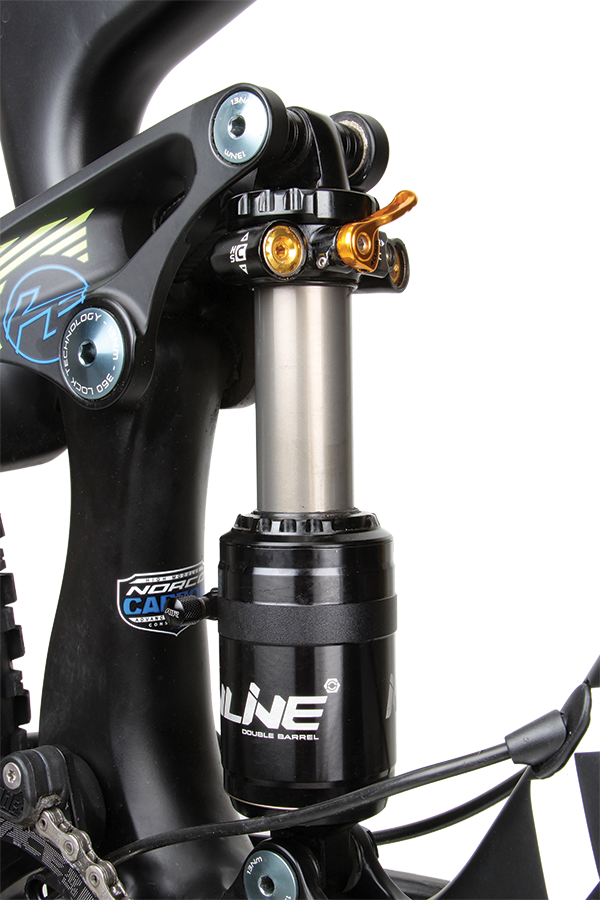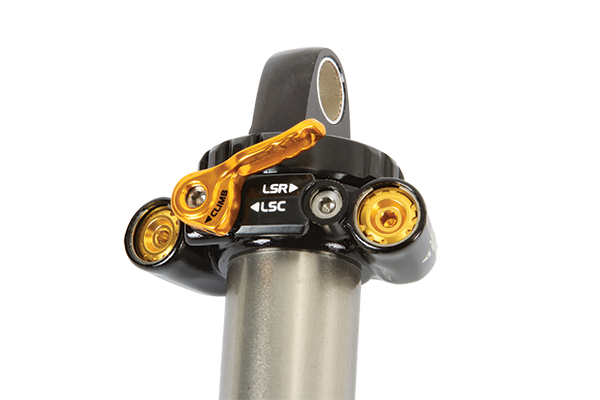Cane Creek Inline Shock
 Back when Cane Creek introduced their Double Barrel Air, it was the most tuneable air shock on the market. It offers external control over the low and high speed compression as well as the low and high speed rebound – each being independently tuneable. While this user tuneable ride held great appeal to some, the size, weight and piggyback format meant the DB Air was always going to have a limited market—it simply wouldn’t fit on many regular trail bikes.
Back when Cane Creek introduced their Double Barrel Air, it was the most tuneable air shock on the market. It offers external control over the low and high speed compression as well as the low and high speed rebound – each being independently tuneable. While this user tuneable ride held great appeal to some, the size, weight and piggyback format meant the DB Air was always going to have a limited market—it simply wouldn’t fit on many regular trail bikes.But now we have the Inline; a shock that bundles up all the same tuning options and delivers them in a lighter and more compact package. It’ll fit most bikes and may allow you to fit a drink bottle within the frame if you wish. At $549 it’s also a good deal cheaper than the DB Air CS and roughly comparable to other high-end XC shocks.
A 216x63mm Double Barrel weighs 510g and the equivalent Inline is 353g. To give this perspective, a regular Fox Float CTD is 260g and a piggyback style RockShox Monarch Plus is 394g (all 216x63). So the Inline is somewhere between the weight of a typical XC shock and a lightweight piggyback shock.
Currently the Inline is the only non-piggyback air shock to offer the full gamut of tuning options. Other air shocks are certainly tuneable, but if you want to change the high-speed compression for example, it’ll require a trip to the service centre for revalving. The Inline lets you do this on the trail with a 3mm allen key.
I fitted the new shock to my 160mm travel Norco Range, replacing the Double Barrel Air CS that it came with the bike. Cane Creek offers a range of ‘base tunes’ for their shocks; it’s basically a starting point for your setup (you’ll find them at www.canecreek.com). With both the DB Air and the Inline, I didn’t have great success with the base tunes. At 63kg I’m probably a good deal lighter than the average American male, so the rebound was unworkably slow when using the suggested settings. It may provide a good setup if you’re in the middle of the weight bell curve; be prepared to fiddle if you’re not.
With the DB Air CS, I had the high speed and low speed rebound very close to the fastest setting and found myself running minimal compression damping too. There’s nothing abnormal about the leverage ratio on the Norco, so it appears that I’m towards the bottom end of the workable rider weight range with the big DB Air. The shock was working great in the end, but it seemed odd to be all the way at one extreme of such a massive adjustment range. The Inline was different and I was no longer at one end of the tuning range. For lighter riders, I feel the Inline shock may be the better choice.
Everyone tends to focus on the damper settings but it’s important to consider the air spring too. The shock is supplied with volume spacers that let you make the shock more ‘progressive’ and resistant to bottoming. These spacers are extremely easy to fit—the shock can even stay on the bike while you do it. The Inline is very linear; it almost uses full travel too readily. I fitted a couple of volume reducers on the Range to make it more progressive, and this allowed me to run less high speed compression damping for a super plush feel.
CALLING CONTROL FREAKS
Between the volume spacers and the four-way adjustable damper, there’s a lot to play with on the Inline, and with the power to adjust comes the risk of getting it all very wrong. Of course it’s easy to zero the settings if you stuff things up, but having some patience and suspension awareness will go a long way.
Once the tune was sorted, the Inline proved to be a great shock and it never felt under gunned on the 160mm travel Norco. Bigger riders and those who tackle half-hour long descents will probably benefit from the added oil volume of the DB Air but for most applications the Inline will be more than sufficient (its twin tube architecture provides around 20% more oil volume than a regular shock).
The ‘Climb Switch’ is another feature that’s shared on both the DB Air CS and the Inline. Other shocks stifle the low-speed compression damping to minimise suspension movement when climbing. Cane Creek takes a slightly different approach. Like most they increase the compression a little but importantly, they noticeably increase the rebound damping too. This proved very effective; the suspension remains able to absorb rocks and step-ups but the subdued rebound stabilises the bike and stops you getting bounced off-line on technical climbs. As the name suggests, the Climb Switch is just for climbing and you’ll probably find the rebound too slow if you leave it in that mode for faster pedally trails.
Both Cane Creek shocks use ‘poppet valves’ to provide the damping force—it gives them a unique feel that’s quite different to shim stack controlled dampers like those from Fox and RockShox. The Inline shock provides a very controlled ride and keeps the tyres feeling glued to the trail. In some ways it feels less ‘lively’ than a traditional shock but in the end it’s the overall tune-ability that really sets the Inline apart. If you like to tinker and take control your damper settings, or if you simply can’t get the required adjustment range from a traditional shock, then the Cane Creek product has your name on it.
Dirt Works Australia (02) 9679 8400 www.dirtworks.com.au






